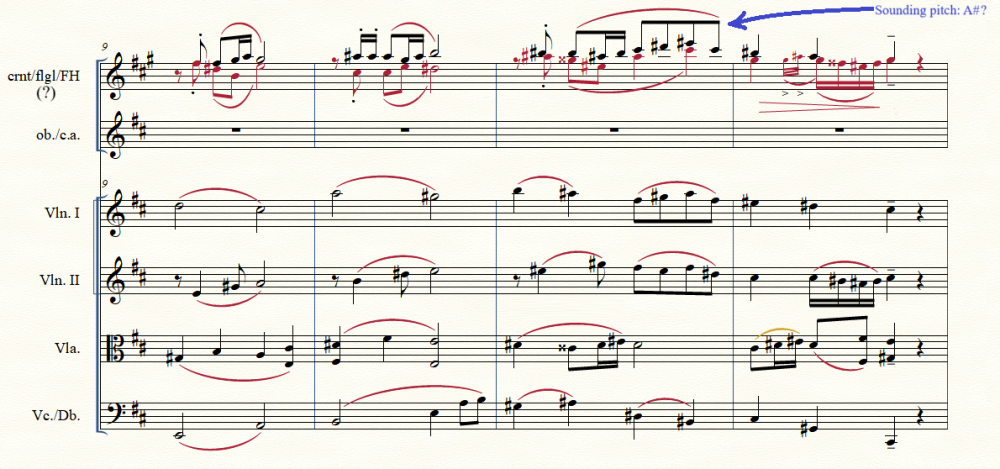
ARCMusicPublishings
Members-
Posts
24 -
Joined
-
Last visited
About ARCMusicPublishings

Profile Information
-
Gender
Male
Recent Profile Visitors
The recent visitors block is disabled and is not being shown to other users.
ARCMusicPublishings's Achievements
-
Thank you, Quinn. Actually, one Violist had demonstrated to me: when he released his finger off the stopped pitch at the same time the arco sprung off of it, the pitch that resonated alongside the stopped pitch was the open-string; not the stopped pitch. Therefore, I conlude from this demonstration that this technique is possible on nothing but open-string (on Strings). Unless someone would like to provide an alternative answer to this ^^, inquiry resolved. 😃
-
Hello, YC community, Is this ^^^ irregular extended technique possible? I understand that Laissez Vibrer (LV) on a string instrument is done on open-string. If the LH finger was released off the stopped-pitch exactly at synchronized time with the arco springing off the string, would that be able to produce the resonation of an open-string LV? Thanks greatly for your help!
-
Hmmm. I don't think this is a problem. It does seem like the best solution. (In the collaborative program that I'm composing for, I am working with a fix-minded, opinionated director, who gives preferential treatment to 'attractive' favorites; and otherwise finds any reason to dogmatically 'scold' others for "not adhering to the instructions". I would sorely fall into the latter category: it seems for petty reasons, I get onto his bad side easily.), and he wouldn't be happy that I submitted two scores; even if it really is just one score with two different versions. The instructions stated "one compositional score only". The director is looking for more instruments and highly recommends us composers to write for larger ensembles (than just string and piano); only so that he can scold me for writing for optional Vibraphone and Wind chimes, when he stated these instruments may be available but isn't confirmed. He would then scold me if I wrote two different score versions that include and exclude it. (Despite the fact that he completely laughed along in obvious support of his "top-notch" composers for writing for two Vibraphone lines, while not knowing at the time if it would or wouldn't be available. He can't have it all three ways.) The reason I'm staying in this summer program and not opting out is because I won't let one irritating faculty member spoil it for me; and my much sought-after time in a prestigious and meaningful compositional opportunity that would bring about a new piece, and its premiere and recording, to be added to my portfolio. In short, I'm "handing it like a grownup would".) I'm sorry, my parenthetical note ran longer than I originally intended, as a became it bit of a rant against this son born of a female canine. And, really. As my high-school choral director always advised: kindly do not complain, unless you have a better, more productive answer.
-
Hello, YoungComposers community, So, I ran into a bit of a hard spot, where I foresee two options (so far), and both have their very ugly drawbacks. I am writing a piece for Violin, Viola, Piano, and percussion: Vibraphone doubling Wind Chimes doubling Cymbals (by 1 percussionist, who will very rarely play these instruments at the same time; and, those 2 or 3 times they do, it is for bit a brief passage and completely coordination-friendly). I plan on having the percussion section as optional. My dilemma: 1 - If in the sheet music I list it as "optional", that would be a slap-in-face insult to the well-learned, highly-talented percussionist who may happen across my piece. It will injure my chances of getting my piece performed, because I'm discouraging players to feel like their instrument is insignificant. 2 - If in the sheet music I didn't list it as "optional", I'm making the piece a whole lot less accessible to performers: I'm requiring many more instruments, some of which are notably less common and not as readily available than just Violin-Viola-Piano (not to mention that a Vibraphone is costly and a bit of a granuloma in the behind to lug around!!). No matter which of these two options I take, a bite in the behind will always be ready for me. So, what do you think would be a good solution for me to alternatively take instead? Thanks and cheers!!
-
(To PeterthePaperComPoser, et al), I appreciate your efforts in assistance. Frankly, after my school's Librarian (or, one of them) has exhausted all his methods of finding this d*mn sheet music, we have come to the conclusion that... it might not actually exist; at least not in modern sheet music. The few performances of it? They could have been read from the original manuscript. We could not find it as a standalone aria nor in a collection of any sort. So, I suppose my next step is to contact the performers (or their agency) and ask them directly how they became acquainted with the music; and what manuscript they were performing from.
-
I suppose I'm not yet sure how to use this website to the benefits of my search. It seems to list the details of what the piece is, without providing the sheet music for it. Also, The SheetMusicPlus link provided leads me to its homepage with search. When I searched this piece there, it was nowhere to be found. Thanks again for your help. Greatly appreciated.
-
Hello, ChemathMusician0510, I realized just now that you were replying to my inquiry. Thanks so much for your insightful advice. I've actually since removed the double-stop, as I found simpler single-stop "Bach-like"-mimics and methods that did the job nearly identically well. But, for my future reference, I'm glad to know that 8v-double-stops like this work. On the other hand, it is located on the lower range of the Cello. From my understanding, this would mean that the hand will have to be stretched. My guess is that some people would say that this is not viable at all. Is this true of the range that I wrote? Or, are you sticking to what you said: that it should be fine? Also, I came across a low stringist who too advised me against the A-flat double-unison. And, so, it too was removed. Cheers, ARCMusicPublishings p. s. The dream school which the final draft of this piece has been submitted to? It has earned me my admission there, which I was greatly excited about. 😃
-
Hello, YCF community, I came across a slight issue when... there is a Piano Vocal piece by Debussy (very beautiful!!) which search for sheet music is driving me nuts!! In all seriousness, I am trying to help a fellow collegiate associate by locating this piece. It is "Flots, Palmes, Sables" by Debussy. Does any one know where I can possibly obtain a copy? If not, can more experienced transcribers describe the meter and any "a piacere"/"liberamente" markings that may appear in a piece like this, so that I can transcribe it myself? How would Debussy have transcribed it? The problem is that, with my limited acquaintance with Debussy's music, I would have made more than several inaccurate notations. So, if there is someone who is more seasoned in transcribing Debussy, I would greatly appreciate the assistance!! Again, this is if no one can locate this mysterious sheet music!! My major goal is to have this transcribed within a week and a half of today: 2/19/25; again, if no existing sheet music of it could be found. Thanks greatly to all who are able to help us in this project! Cheers, ARCMusicPublishings
-
Hello, According to this Wikipedia article: Tubular bells - Wikipedia, "They can also be bowed at the bottom of the tube to produce a very loud, very high-pitched overtone." I was a bit curious about the mention of this, and want to see if I can learn as much about it as possible. Does this technique use string bows? Or the default TB Hammer mallet? Also, is there a video that can demonstrate this? I've searched "tubular bells" "bowing" and "tubular bells" "bow". I couldn't find anything about it. In this very nice TB performance by Dr. Geoff Shiel, there were moments of tambourine-like effect. (e. g. 3:42-45, 5:15-20, 5:31-33, 5:58-6:12) (As I'm assuming certain tubes were reconfigured in an irregular way) How exactly was this produced? Thanks for your all's help!
-
Irregular method of playing the Viola
ARCMusicPublishings replied to ARCMusicPublishings's topic in Composers' Headquarters
Thank you again, Quinnn, for your response. The original idea which I was entertaining was, a Violist can play supra-8va double-stops more easily with deployment of the thumb for fingering. Also, on a casual note, I envision that it could be very neat for a visual affect. (I am in the progress of composing a sentimental aria in an Opera, where a Contralto sings about a historic figure; to her Chamber Church congregants. As the audience would be able to see the pit orchestra, I planned on having the Violists play either with their instrument sitting upright on their left knee; or perhaps standing up on some modified long 2-feet peg. It would nicely help illustrate the sentimental "motherly" history lesson.) -
Horn Transpositions
ARCMusicPublishings replied to ARCMusicPublishings's topic in Composers' Headquarters
I thought I replied to Quinn days ago. (Blasted internet connection back at that library... >=S) Quinn, thanks for the instrumental reference. I've never heard of a Triple-Horn before. Needless to say, there are many variations of classical instruments that I haven't learned about. (For example, we have a 5- and 6-string Violin-Viola combo, which range spans from a Viola to a Violin on C-,G-,D-,A- and E-string. With the size of a Violin, C-string sounds very nasily. And then, some 5-string Viola variation has an F-String, which serves as some Alta Profunda to C-String. Sorry, totally off the topic at hand!) I don't think I found a Wikipedia article on the Triple-Horn. When was it invented? Better yet, was it used during the Classical Period? The Symphonic Sonatina that I wrote above is meant to "accurately" illustrate the styles of the Classical era, so I wanted to be as "accurate" as possible. -
Hello, As I understand that the French Horn's standard range reaches as high as sounding-pitch F5 (F a Perfect 4th above 'High C'), are any of the horns that transposes up able to reach a B5 (half-step below C6)? What are the sounding ranges of these horns, specifically their highest standard playable note? Would most or all of them be the same as the French Horn (F5), written in their respective transposition? I've written a chamber orchestra Sonatina (Classical-era style!), with a non-Trumpet Brass part that requires a range up to B5, which I understand is difficult for an FH to achieve, without it being played by some professionally virtuosic Hornist. My goal is to find a Horn which standard range would include these high-sounding notes above F5. As you can see in the attached sample below, which is the Expositon's transition into the second tonal theme, the non-Trpt. Brass instrument would reach a high A#5. (In the recapitulation section, which isn't shown, the second-tonal theme contains a horn accomp. passage that does reach a B5.) Thanks to all for your help.
-
Irregular method of playing the Viola
ARCMusicPublishings replied to ARCMusicPublishings's topic in Composers' Headquarters
Hmmm. I seemed to have received no answer to this inquiry. It is still current for anyone who may have insight to it. Thanks again. -
Hello, Young Composers Community, This is a neat and curious idea that came to mind as a composer dipping his toes in writing a Viola sonata for Viola and Piano, and I thought I'd ask experienced string players this one. Would there be any sound and/or playability benefits to playing the Viola upright, similar to how one plays the cello: having it stand on the player's lap, or perhaps on some endpin, versus the default of placing it on player's shoulder? This is something I was entertaining to include in my score's stage note, primarily for visual effects: there is a virtuosic section that involves 32-note and triple-stop passages, which I would love the audience to see be demonstrated; loosely similar to how Franz Liszt was the innovator of turning the piano sideways so that the audience could visually observe his fingers perform his difficult Etude. I guess, then, my real question is: would there be any substantial inconveniences and hindrances to playing the Viola this irregular way? I'm sure this idea isn't exactly original and has possibly been entertained and even done before by composers and string players who came before me; which is why I am curious about it. Thanks.




